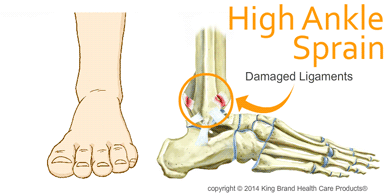High Ankle Injuries
by Sports Physio Greg Wootton B.Sc (physio), M Sport Physio
 High ankle injuries involve the separation of the two bones of the lower leg- the tibia and the fibula as part of the ankle joint, but not typically just the outside of the ankle joint as occurs in a normal sprain or ankle twisting episode. These two bones (tibia and fibula) are held together by a series of ligaments and a fibrous band of tissue connecting the two bones along their length, called an interosseous membrane. Forces on the lower leg or ankle may cause the separation (or diastasis) of these two bones, stretching and tearing the ligaments and interosseous membrane.
High ankle injuries involve the separation of the two bones of the lower leg- the tibia and the fibula as part of the ankle joint, but not typically just the outside of the ankle joint as occurs in a normal sprain or ankle twisting episode. These two bones (tibia and fibula) are held together by a series of ligaments and a fibrous band of tissue connecting the two bones along their length, called an interosseous membrane. Forces on the lower leg or ankle may cause the separation (or diastasis) of these two bones, stretching and tearing the ligaments and interosseous membrane.
The most typical mechanism of injury to the high ankle is for the foot to externally rotate (or turn out) on the lower leg. This may occur when an athlete pivots internally on a fixed foot; or when contact from a competitor forces the lower leg inwards on a planted foot; or from a direct blow to the lower leg or ankle forcing the foot and leg into this position. There has also been high ankle injuries reported from forced hyperdorsiflexion (forced ankle bend) and the more typical inversion or eversion injuries of the ankle.
There is an increased incidence of these types of injuries reported in contact sports such as football and hockey (in particular ice hockey). Surfing has also been reported as a risk factor as surfers are forced into hyperdorsiflexion with a steep drop onto the wave face.
Signs and Symptoms
The typical symptoms of high ankle injuries are pain and difficulty weight bearing on the affected lower leg, and particularly pain to push off or heel raise. Dorsiflexion (ankle bend) range- particularly in weight bearing – may also be significantly painful and limited. There are several orthopaedic tests that your Physio will use to help diagnose this injury including the external rotation test, squeeze test, drawer and Cotton test . Diagnosis may then be confirmed via investigation, with the MRI the most reliable of the modalities.
Management
Typically the high ankle injury is managed by reducing inflammation and immobilising the lower leg so as to allow ligamentous repair. In more severe injuries the ligamentous damage is so significant that the high ankle remains unstable and unable to tolerate full weight bearing activity due to the separation of the bones and surgery may be required. Previously the surgical repair would involve the two bones of the lower leg being internally fixated with a screw. An alternative technique has now been developed, the TightRope Syndesmosis Repair or Athrex procedure, which involves a button like attachment of a polyethelene chord to the med tibia which is then tightened around the fibula to firmly hold the two bones in position.
If surgery is needed and not performed, there is a high risk of early Osteoarthritis in the ankle joint so it becomes important to diagnose these injuries early and follow an appropriate management pathway.
If you have experienced on-going ankle or shin symptoms related to an acute traumatic event such as an ankle sprain, make sure you come and see one of our Gold Coast Physio & Sports Health Physio’s to ensure you get the correct diagnosis and pathway of management.
